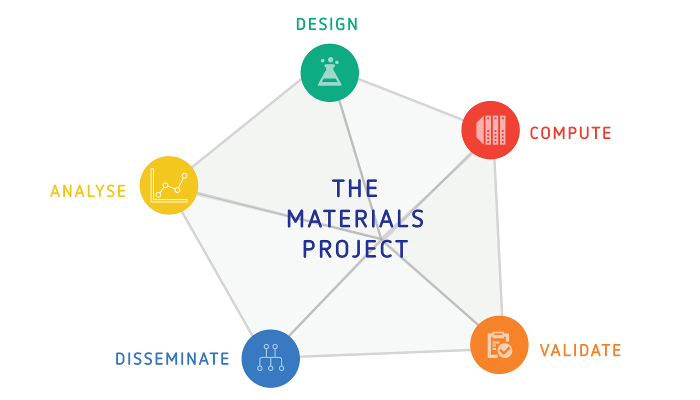
“What are you cooking for me tonight?” asks your girlfriend of two weeks. You nearly forgot your promise to cook dinner for her on this Friday evening. How are you supposed to prepare a nice meal when the only recipes you can recall are for packaged ramen and scrambled eggs? You grab your iPad, do a “Google” search, and come across a recipe for miso-glazed salmon. Bingo! Google saves the day.
Or maybe you’re a student. You missed your math lecture and have no idea what an isomorphism is. What do you do? You “Google” it, of course. Google saves the day once again.
But what do scientists who are conducting research do? They don’t “Google” the answers, do they? Usually, we think of scientists as the ones who put the answers on Google for us to read about. However, it may surprise you to know that there does exist a Google-like database that tens of thousands of scientists all over the world use today.
This database is known as the Materials Project and was cofounded in 2011 by Dr. Kristin Persson, a faculty member of the Materials Science Department at UC Berkeley and staff scientist at the Lawrence Berkeley National Laboratory.
Everything we use is made out of materials, but how do we decide which materials to use? Depending on the application of the product, we may be interested in different properties. Take the brakes on a car, for example. When we brake, the friction used to stop the car generates a large amount of heat and thus the brake is exposed to very high temperatures. An important consideration when designing the brakes of a car may be the strength of the metal alloy at high temperatures. Now let’s look at a different part of the car. What materials properties are we interested in when designing a car battery? In this case we are more concerned with properties such as electrical conductivity of the materials used.
The data provided by the Materials Project can help scientists looking for materials to use in car design and applications beyond. Existing applications range from things such as finding more efficient materials to use in solar panels to analyzing cement in outer space! The number of chemical compounds we can choose from to make these materials is on the order of tens of thousands. In order to experimentally determine the properties of all these compounds, an unfathomable amount of time and resources would be required. Scientists collaborating on the Materials Project have found a way to get around this using basic principles of physics. At an atomic scale and even smaller, all elements have characteristics that dictate how they behave on a macroscopic scale. These characteristics can be described by a field of physics known as quantum mechanics. By solving equations from quantum mechanics, scientists can predict some of the macroscopic properties of materials. In the past, this too was unfathomable due to the complexity of quantum equations. However in the age of supercomputers, it is now possible to crunch these equations and develop models to predict the properties of materials with relative ease. Supercomputers, which can be found at the Lawrence Berkeley National Laboratory, are much more powerful than our everyday laptops and desktops and can operate at exceptionally high speeds. Because properties of materials can be determined by computation and without experiment, it is now possible for scientists using the Materials Project to predict the properties of materials that haven’t even been synthesized and only exist in theory. With this wealth of information at their disposal, scientists can select materials with properties that fit their needs and can eliminate the trial and error previously required to determine which materials were viable for their applications. This saves scientists both time and money when developing new products.
Currently, the Materials Project has properties for more than 65,000 compounds available to its users (you can sign up here: https://www.materialsproject.org/). Users can also request data for materials not already in the database and have its properties calculated through the Project portal nearly instantaneously, courtesy of the supercomputers at XSEDE (Extreme Science and Engineering Discovery Environment). On the other hand, users can submit materials properties they have determined to the Materials Project that are not already in the database. The Materials Project also has mobile applications for its users interested in specific materials applications (i.e. batteries) or specific materials properties. This versatility of the Materials Project has attracted users from all over the world, from both industry and academia.
While initial data provided by the Materials Project were largely centered on electronic properties for semiconductor and battery research, data on other physical properties such as elasticity have grown rapidly in recent months. The elastic properties of materials are difficult to determine experimentally because they require high-quality materials and high-precision measurements, which are costly and time-consuming. Looking ahead, the 13-member Materials Project team at Berkeley is looking to increase the size and diversity of the database. One specific area that Dr. Persson hopes to be able to address in the future is the difficulty of synthesizing the materials that only exist in theory.
In this way, the Materials Project is revolutionizing the way in which materials research is done. Properties that were previously unknown and difficult to determine can now be determined relatively quickly and accurately. Dr. Persson claims, “Properties that used to take one year to determine experimentally can now be computed within hours.” By pairing materials research with the exponential growth of computing power, researchers collaborating on the Materials Project have been able to accelerate innovation in the field of materials science.
Feature image courtesy the Persson group.





